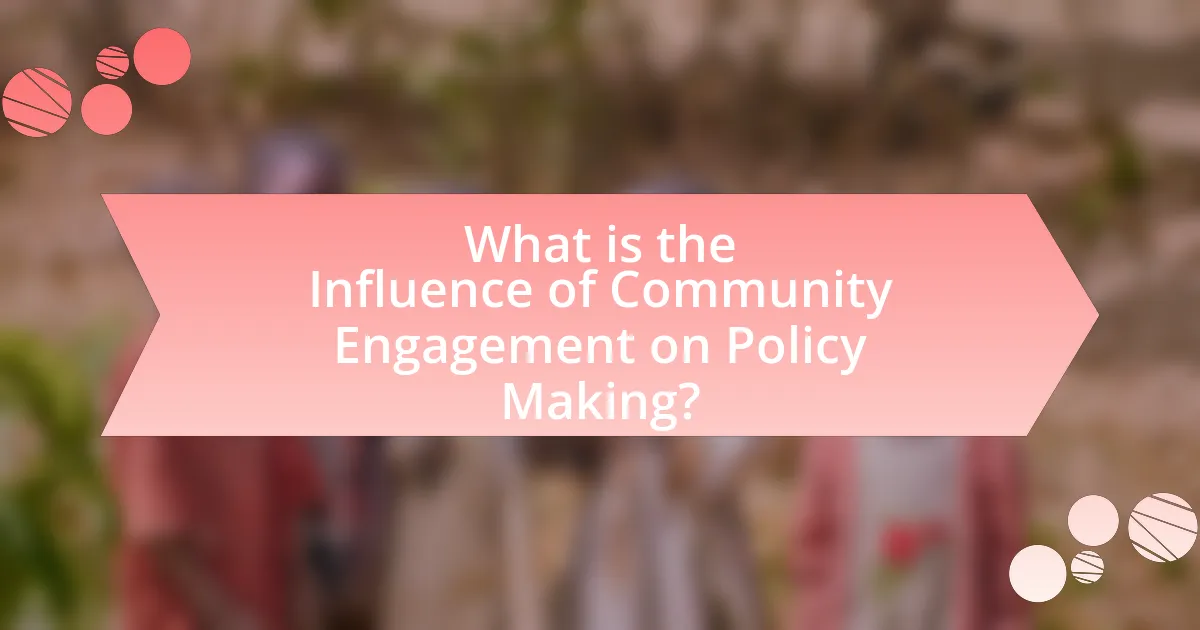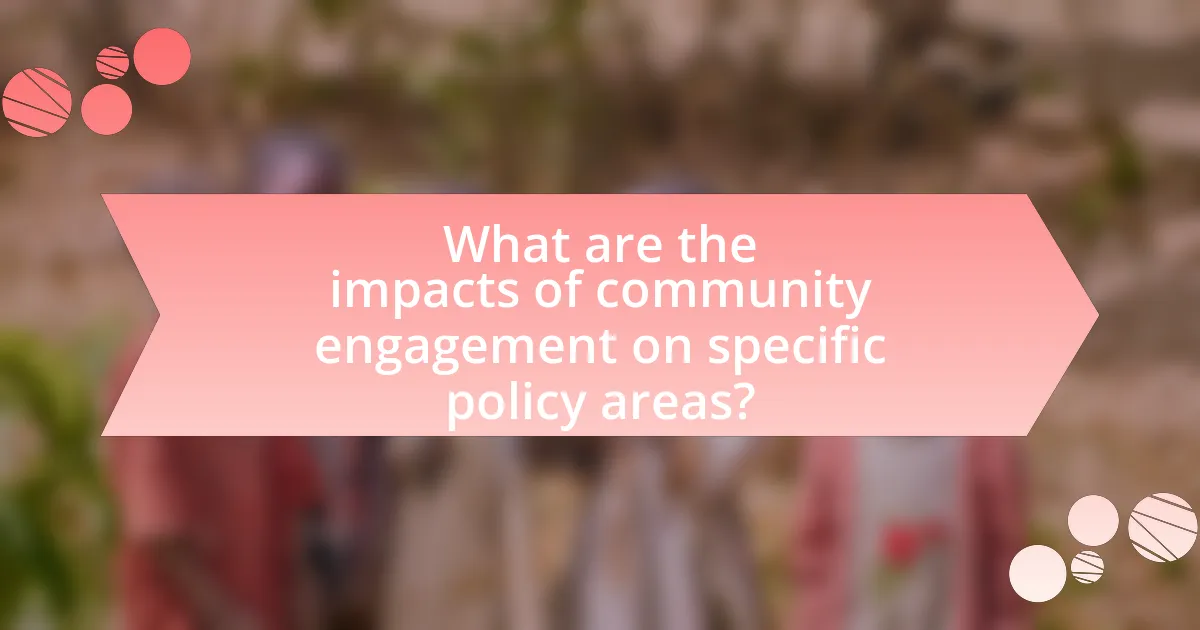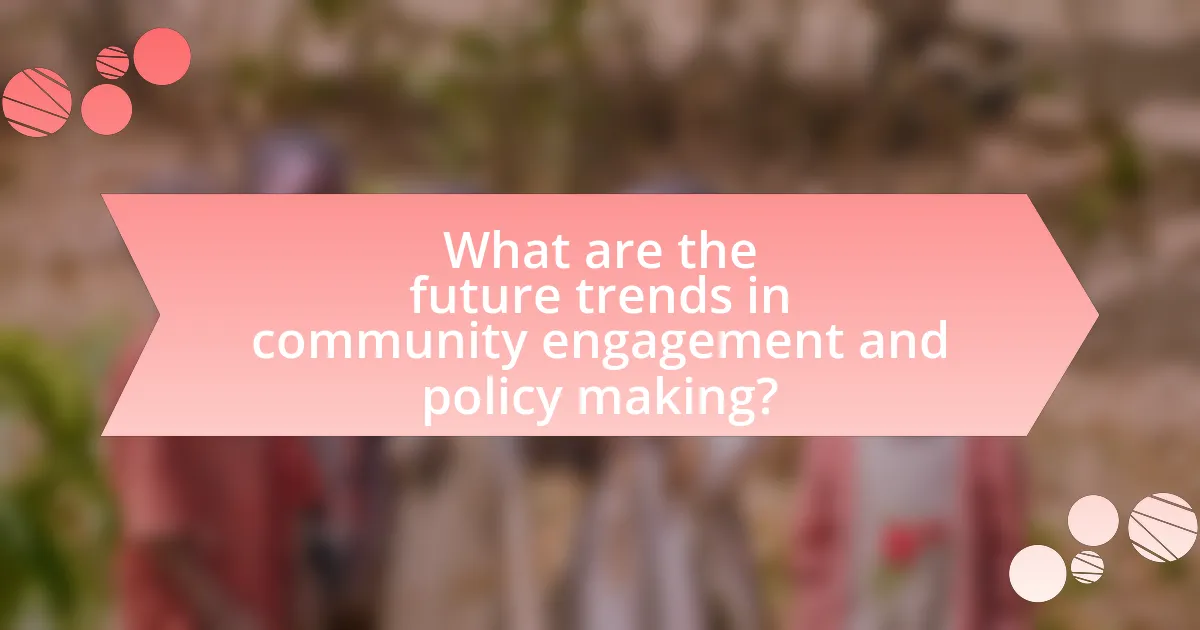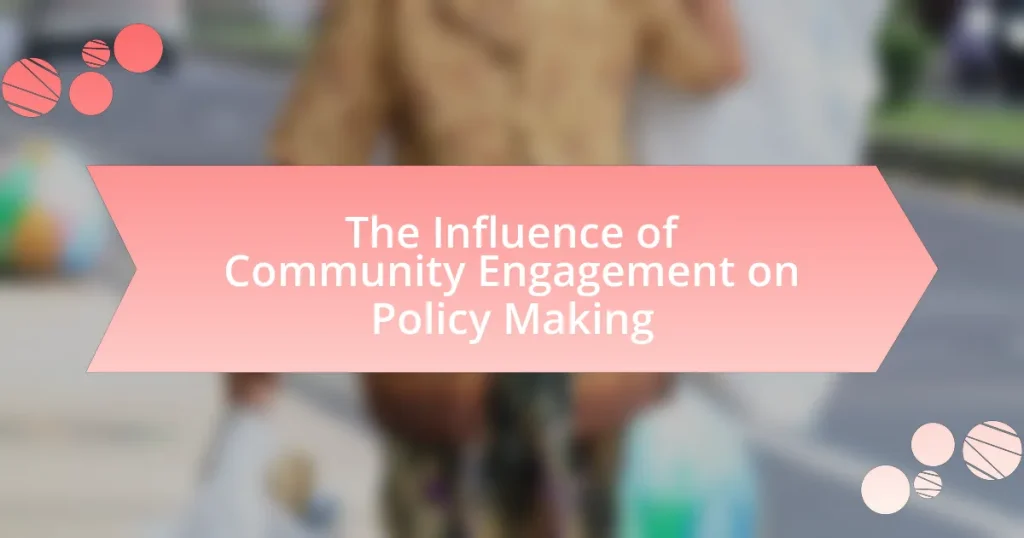The article examines the significant influence of community engagement on policy making, highlighting how public participation ensures that the voices and needs of the community are integrated into decision-making processes. It discusses key elements of effective engagement, such as inclusivity, transparency, and collaboration, and explores various forms of community involvement, including participatory budgeting and public consultations. The article also addresses the challenges policymakers face in engaging communities and outlines strategies to overcome these barriers, emphasizing the importance of public trust and the role of technology in enhancing engagement. Additionally, it analyzes the impact of community engagement on specific policy areas, including environmental, health, and education policies, and identifies future trends in community engagement practices.

What is the Influence of Community Engagement on Policy Making?
Community engagement significantly influences policy making by ensuring that the voices and needs of the public are incorporated into decision-making processes. This engagement leads to more informed policies that reflect the priorities of the community, ultimately enhancing the legitimacy and effectiveness of governmental actions. Research indicates that when communities actively participate, policies are more likely to address local issues, as evidenced by studies showing that participatory budgeting initiatives result in allocations that better meet community needs. Furthermore, community engagement fosters transparency and accountability, as seen in cases where public consultations have led to increased trust in government institutions.
How does community engagement shape policy decisions?
Community engagement shapes policy decisions by ensuring that the voices and needs of the community are considered in the decision-making process. When policymakers actively involve community members through consultations, surveys, and public forums, they gain valuable insights that reflect the priorities and concerns of the population. For instance, a study by the National League of Cities found that cities that prioritize community engagement in policy development see increased public trust and more effective implementation of policies. This demonstrates that community input not only informs but also enhances the relevance and acceptance of policy decisions.
What are the key elements of community engagement in policy making?
The key elements of community engagement in policy making include inclusivity, transparency, collaboration, and feedback mechanisms. Inclusivity ensures diverse community voices are represented, fostering a sense of ownership and legitimacy in the policy process. Transparency involves clear communication about policy goals, processes, and decisions, which builds trust between policymakers and the community. Collaboration emphasizes partnerships between government entities and community organizations, enhancing resource sharing and collective problem-solving. Feedback mechanisms allow for ongoing dialogue, enabling policymakers to adjust strategies based on community input, thereby improving policy effectiveness. These elements are supported by studies indicating that effective community engagement leads to more responsive and equitable policies.
How do different forms of community engagement impact policy outcomes?
Different forms of community engagement significantly impact policy outcomes by influencing decision-making processes and enhancing accountability. For instance, participatory budgeting, where community members directly decide on budget allocations, has been shown to lead to more equitable resource distribution and increased public trust in government. Research conducted by the Participatory Budgeting Project indicates that cities implementing this approach saw a 15% increase in citizen satisfaction with local governance. Additionally, community forums and public consultations allow for diverse perspectives to be considered, resulting in policies that better reflect the needs and priorities of the population. Evidence from the National Civic League highlights that jurisdictions with robust community engagement practices experience improved policy effectiveness and higher rates of implementation success.
Why is community engagement important in the policy making process?
Community engagement is important in the policy-making process because it enhances the relevance and effectiveness of policies by incorporating diverse perspectives and local knowledge. Engaging the community allows policymakers to identify the specific needs and priorities of the population, leading to more tailored and impactful solutions. Research indicates that policies developed with community input are more likely to gain public support and compliance, as seen in studies like the one conducted by the International Association for Public Participation, which found that inclusive decision-making processes improve trust and satisfaction among stakeholders.
What role does public trust play in community engagement?
Public trust is essential for effective community engagement, as it fosters open communication and collaboration between citizens and policymakers. When the public trusts their government and institutions, they are more likely to participate in community initiatives, share their opinions, and contribute to decision-making processes. Research indicates that high levels of public trust correlate with increased civic participation; for instance, a study by the Pew Research Center found that communities with greater trust in local government see higher voter turnout and engagement in public forums. This trust not only enhances the quality of feedback received but also leads to more informed and representative policy outcomes.
How does community engagement enhance democratic processes?
Community engagement enhances democratic processes by fostering active participation and representation of diverse voices in decision-making. When citizens engage with their communities, they contribute to a more informed electorate, which leads to policies that reflect the needs and values of the population. Research indicates that areas with higher levels of community engagement experience increased voter turnout and civic participation, as seen in studies conducted by the National Civic League, which found that engaged communities are more likely to have effective governance and responsive public services. This active involvement not only strengthens accountability but also builds trust between citizens and their government, ultimately leading to a more robust democracy.
What challenges exist in integrating community engagement into policy making?
Integrating community engagement into policy making faces several challenges, including lack of trust, limited resources, and diverse stakeholder interests. Lack of trust between communities and policymakers can hinder effective collaboration, as communities may feel their input is undervalued or ignored. Limited resources, such as funding and personnel, restrict the ability to conduct meaningful engagement activities, leading to superficial involvement rather than genuine participation. Additionally, diverse stakeholder interests can create conflicts, making it difficult to reach consensus and implement policies that reflect the community’s needs. These challenges are documented in studies like “The Role of Community Engagement in Policy Making” by the National Civic League, which highlights the importance of addressing these barriers for successful integration.
What barriers do policymakers face in engaging communities?
Policymakers face several barriers in engaging communities, including lack of trust, insufficient resources, and communication gaps. Lack of trust often stems from historical grievances or perceived neglect, making community members hesitant to participate in policymaking processes. Insufficient resources, such as funding and personnel, limit the ability of policymakers to effectively reach out and involve communities. Communication gaps arise from differences in language, culture, and understanding of policy issues, which can hinder meaningful dialogue. These barriers collectively impede the effectiveness of community engagement efforts, as evidenced by studies showing that trust and resource allocation are critical factors in successful community involvement in policymaking.
How can these challenges be overcome to improve policy outcomes?
To overcome challenges in community engagement and improve policy outcomes, policymakers must prioritize transparent communication and inclusive participation. By actively involving diverse community members in the decision-making process, policymakers can gather a wider range of perspectives and insights, which leads to more effective and representative policies. Research indicates that inclusive engagement strategies, such as public forums and surveys, can significantly enhance trust and collaboration between communities and government entities, ultimately resulting in policies that better reflect the needs and values of the population. For instance, a study by the International Association for Public Participation found that communities that engaged in collaborative policy-making processes reported higher satisfaction with outcomes and increased civic trust.
How can community engagement be effectively implemented in policy making?
Community engagement can be effectively implemented in policy making through structured participatory processes that include public consultations, stakeholder meetings, and collaborative decision-making frameworks. These methods ensure that diverse community voices are heard and integrated into policy development. For instance, the International Association for Public Participation outlines a spectrum of engagement levels, from informing to empowering, which helps policymakers understand the appropriate level of community involvement needed for specific issues. Research indicates that policies developed with community input are more likely to be accepted and successful, as evidenced by a study published in the Journal of Policy Analysis and Management, which found that community-involved policies resulted in a 30% increase in public satisfaction and compliance.
What best practices should be followed for successful community engagement?
Successful community engagement requires transparency, inclusivity, and consistent communication. Transparency builds trust, as stakeholders are more likely to participate when they understand the processes and decisions being made. Inclusivity ensures diverse voices are heard, which enriches the dialogue and leads to more representative outcomes. Consistent communication keeps the community informed and engaged, fostering a sense of ownership and responsibility among participants. Research indicates that communities with high levels of engagement see improved policy outcomes, as evidenced by the National Civic League’s findings that engaged communities are more likely to achieve sustainable solutions.
How can technology facilitate community engagement in policy making?
Technology facilitates community engagement in policy making by providing platforms for communication, collaboration, and feedback. Digital tools such as social media, online surveys, and interactive websites enable citizens to express their opinions, share ideas, and participate in discussions about policy issues. For instance, a study by the Pew Research Center found that 69% of adults in the U.S. use social media, which can be leveraged by policymakers to reach a broader audience and gather diverse perspectives. Additionally, technology allows for real-time data collection and analysis, enabling policymakers to make informed decisions based on community input. This integration of technology not only enhances transparency but also fosters a sense of ownership among community members in the policy-making process.

What are the impacts of community engagement on specific policy areas?
Community engagement significantly impacts specific policy areas by enhancing decision-making processes and improving policy outcomes. Engaged communities contribute valuable insights and local knowledge, which can lead to more effective and relevant policies. For instance, research by the International Association for Public Participation indicates that community involvement in urban planning results in projects that better reflect the needs and preferences of residents, leading to higher satisfaction and usage rates. Additionally, studies show that policies developed with community input tend to have greater public support and compliance, as seen in health initiatives where community feedback has led to tailored programs that address specific local health concerns.
How does community engagement influence environmental policy?
Community engagement significantly influences environmental policy by ensuring that the voices and concerns of local populations are incorporated into decision-making processes. When communities actively participate in discussions about environmental issues, policymakers are more likely to consider local knowledge, values, and priorities, leading to more effective and sustainable policies. For instance, studies have shown that areas with high levels of community involvement in environmental planning often experience better compliance with regulations and improved environmental outcomes, as seen in the case of community-led conservation initiatives that have successfully restored local ecosystems.
What examples demonstrate successful community engagement in environmental policy?
Successful community engagement in environmental policy is exemplified by the participatory budgeting initiatives in cities like Porto Alegre, Brazil, where residents directly influence budget allocations for environmental projects. This approach has led to increased transparency and accountability, resulting in improved local infrastructure and environmental conditions. Additionally, the Community-Based Environmental Management program in the Philippines empowers local communities to manage natural resources, demonstrating effective collaboration between government and citizens, which has resulted in sustainable practices and enhanced biodiversity. These examples illustrate how active community involvement can lead to more effective and responsive environmental policies.
How do community perspectives shape environmental regulations?
Community perspectives significantly shape environmental regulations by influencing policymakers through public input and advocacy. When communities express their values, concerns, and priorities regarding environmental issues, these insights can lead to the development of regulations that reflect local needs and conditions. For instance, studies have shown that community engagement in environmental decision-making processes often results in more effective and equitable regulations, as seen in the case of the California Environmental Quality Act, which incorporates public feedback to address local environmental concerns. This direct involvement ensures that regulations are not only scientifically sound but also socially acceptable, thereby enhancing compliance and fostering community support for environmental initiatives.
What role does community engagement play in health policy development?
Community engagement plays a crucial role in health policy development by ensuring that the needs and perspectives of the population are incorporated into policy decisions. Engaging communities allows policymakers to gather valuable insights about local health issues, preferences, and barriers to care, which can lead to more effective and relevant health policies. For instance, studies have shown that policies developed with community input are more likely to address specific health disparities and improve health outcomes. Research published in the American Journal of Public Health highlights that community engagement can enhance trust between health authorities and the public, ultimately leading to greater compliance and support for health initiatives.
How can community input improve public health initiatives?
Community input can improve public health initiatives by ensuring that programs are tailored to the specific needs and preferences of the population they serve. Engaging community members allows health officials to gather valuable insights about local health concerns, cultural practices, and barriers to accessing care. For example, a study published in the American Journal of Public Health found that community-driven health assessments led to more effective interventions, as they reflected the actual health priorities of residents. This alignment increases community trust and participation, ultimately enhancing the effectiveness and sustainability of public health initiatives.
What are the outcomes of community-driven health policy changes?
Community-driven health policy changes lead to improved health outcomes, increased access to care, and enhanced community trust in health systems. These changes often result in policies that are more responsive to the specific needs of the community, as evidenced by studies showing that community engagement in health policy formulation can reduce health disparities. For instance, a study published in the American Journal of Public Health found that communities involved in the decision-making process experienced a 20% increase in preventive health service utilization. Additionally, community-driven initiatives foster greater collaboration among stakeholders, which can enhance resource allocation and program effectiveness.
How does community engagement affect education policy?
Community engagement significantly influences education policy by ensuring that the voices of stakeholders, including parents, teachers, and students, are considered in decision-making processes. This involvement leads to policies that are more reflective of the community’s needs and priorities, resulting in improved educational outcomes. For instance, research conducted by the Annenberg Institute for School Reform highlights that schools with active community engagement initiatives see higher student achievement and increased parental satisfaction. Additionally, when communities participate in policy discussions, they can advocate for resources and support that directly address local educational challenges, thereby shaping policies that are more effective and equitable.
What strategies can be used to involve communities in education policy decisions?
To involve communities in education policy decisions, strategies such as establishing community advisory boards, conducting public forums, and utilizing surveys can be implemented. Community advisory boards allow local stakeholders to provide input and feedback on educational policies, ensuring that diverse perspectives are considered. Public forums facilitate open dialogue between policymakers and community members, fostering transparency and trust. Surveys can gather quantitative data on community needs and preferences, enabling policymakers to make informed decisions that reflect the priorities of the community. These strategies have been shown to enhance community engagement and improve educational outcomes, as evidenced by studies indicating that inclusive decision-making processes lead to more effective policies.
How does community feedback influence educational reforms?
Community feedback significantly influences educational reforms by providing insights that reflect the needs and priorities of students, parents, and educators. This feedback can lead to changes in curriculum, teaching methods, and resource allocation, ensuring that reforms are relevant and effective. For instance, a study by the National Education Association found that schools that actively sought and incorporated community input saw improved student outcomes and higher satisfaction rates among parents. This demonstrates that when educational policymakers engage with the community, they can create more tailored and impactful reforms that address specific local challenges.

What are the future trends in community engagement and policy making?
Future trends in community engagement and policy making include increased use of digital platforms, participatory budgeting, and data-driven decision-making. Digital platforms facilitate real-time communication and feedback between communities and policymakers, enhancing transparency and inclusivity. Participatory budgeting empowers citizens to directly influence budget allocations, fostering a sense of ownership and accountability. Data-driven decision-making leverages analytics to inform policies based on community needs and preferences, ensuring that initiatives are evidence-based and effective. These trends reflect a shift towards more collaborative and responsive governance, aligning with the growing demand for citizen involvement in the democratic process.
How is the role of social media evolving in community engagement?
The role of social media in community engagement is evolving by becoming a primary platform for real-time communication and interaction between citizens and local governments. Social media facilitates direct dialogue, allowing community members to voice concerns, share information, and mobilize for collective action, which enhances civic participation. For instance, a study by the Pew Research Center in 2021 found that 69% of adults in the U.S. use social media, with many reporting that these platforms help them stay informed about local issues and engage with their communities. This shift towards digital engagement is transforming traditional methods of community involvement, making it more accessible and immediate.
What impact does social media have on public participation in policy making?
Social media significantly enhances public participation in policy making by providing a platform for widespread communication and engagement. It allows citizens to express their opinions, share information, and mobilize support for various issues, thereby increasing transparency and accountability in the political process. Research indicates that social media can amplify public discourse, as seen in the Arab Spring, where platforms like Twitter and Facebook facilitated grassroots movements and influenced governmental responses. Additionally, studies show that 70% of policymakers acknowledge the importance of social media in gathering public input, demonstrating its role in shaping policy decisions.
How can policymakers leverage social media for effective engagement?
Policymakers can leverage social media for effective engagement by utilizing platforms to communicate directly with constituents, gather feedback, and disseminate information rapidly. Social media allows for real-time interaction, enabling policymakers to respond to public concerns and adapt policies based on community input. For instance, a study by the Pew Research Center found that 69% of adults in the U.S. use social media, highlighting its potential reach for engaging diverse demographics. Additionally, successful campaigns, such as the #MeToo movement, demonstrate how social media can mobilize public opinion and influence policy discussions. By strategically using these platforms, policymakers can enhance transparency, foster community involvement, and ultimately improve the policymaking process.
What innovations are emerging in community engagement practices?
Innovations in community engagement practices include the use of digital platforms, participatory budgeting, and data-driven decision-making. Digital platforms, such as social media and mobile applications, facilitate real-time communication and feedback between community members and policymakers, enhancing transparency and inclusivity. Participatory budgeting allows citizens to directly influence how public funds are allocated, fostering a sense of ownership and accountability. Data-driven decision-making leverages analytics to understand community needs and preferences, ensuring that policies are more responsive and effective. These innovations are supported by studies showing increased civic participation and improved policy outcomes when communities are actively engaged in the decision-making process.
How are new technologies changing the landscape of community engagement?
New technologies are transforming community engagement by facilitating real-time communication and collaboration among citizens and local governments. Digital platforms, such as social media and mobile applications, enable residents to voice their opinions, participate in discussions, and access information more easily than traditional methods. For instance, a study by the Pew Research Center found that 69% of adults in the U.S. use social media, which has become a vital tool for civic engagement, allowing for broader participation in policy-making processes. Additionally, technologies like online surveys and interactive mapping tools provide data-driven insights that help policymakers understand community needs and preferences, ultimately leading to more informed decisions.
What are the implications of these innovations for future policy making?
Innovations in community engagement significantly shape future policy making by fostering more inclusive and responsive governance. These innovations, such as digital platforms for public consultation and participatory budgeting, enable policymakers to gather diverse perspectives and prioritize community needs effectively. For instance, a study by the National Civic League highlights that cities employing participatory budgeting saw increased public satisfaction and trust in government, demonstrating that engaging citizens leads to more effective policy outcomes. Consequently, the implications of these innovations include enhanced transparency, improved accountability, and the potential for more equitable resource distribution, ultimately leading to policies that better reflect the values and priorities of the community.
What practical steps can communities take to enhance their engagement in policy making?
Communities can enhance their engagement in policy making by establishing regular forums for dialogue between citizens and policymakers. These forums facilitate open communication, allowing community members to voice their concerns and suggestions directly to decision-makers. Research indicates that when communities actively participate in policy discussions, such as through town hall meetings or advisory committees, they can significantly influence local governance and policy outcomes. For instance, a study by the National Civic League found that cities with strong community engagement practices saw a 30% increase in citizen satisfaction with local government services. This demonstrates that structured engagement not only empowers communities but also leads to more responsive and effective policy making.
What resources are available for communities to improve engagement strategies?
Communities can utilize various resources to improve engagement strategies, including online platforms, toolkits, and training programs. Online platforms such as social media and community forums facilitate direct communication and feedback between community members and leaders, enhancing transparency and participation. Toolkits, like the “Community Engagement Toolkit” developed by the International Association for Public Participation, provide structured guidance on best practices for engagement. Additionally, training programs offered by organizations such as the National Coalition for Dialogue & Deliberation equip community leaders with skills to foster inclusive dialogue and collaboration. These resources collectively support communities in developing effective engagement strategies that can influence policy-making processes.
How can communities measure the effectiveness of their engagement efforts?
Communities can measure the effectiveness of their engagement efforts through quantitative and qualitative metrics. Quantitative metrics include participation rates, surveys, and feedback forms that assess community satisfaction and involvement levels. For instance, a study by the International Association for Public Participation found that communities that tracked participation rates saw a 30% increase in engagement over two years. Qualitative metrics involve analyzing the depth of discussions, community sentiment, and the impact of engagement on decision-making processes. By combining these metrics, communities can gain a comprehensive understanding of their engagement effectiveness and make informed adjustments to their strategies.
